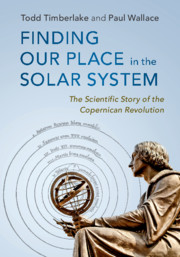Book contents
- Frontmatter
- Dedication
- Contents
- Preface
- 1 Introduction: mysterious skies
- 2 Two spheres: modeling the heavens and the Earth
- 3 Wanderers: the Moon and the planets
- 4 An Earth-centered cosmos: astronomy and cosmology from
- 5 Moving the Earth: the revolutions of Copernicus
- 6 Instruments of reform: Tycho’s restoration of observational
- 7 Physical causes: Kepler’s new astronomy
- 8 Seeing beyond Aristotle: Galileo’s controversies
- 9 The system of the world: Newton’s universal physics
- 10 Confirming Copernicus: evidence for Earth’s motions
- Appendix Mathematical details
- Notes
- References
- Index
8 - Seeing beyond Aristotle: Galileo’s controversies
Published online by Cambridge University Press: 18 March 2019
- Frontmatter
- Dedication
- Contents
- Preface
- 1 Introduction: mysterious skies
- 2 Two spheres: modeling the heavens and the Earth
- 3 Wanderers: the Moon and the planets
- 4 An Earth-centered cosmos: astronomy and cosmology from
- 5 Moving the Earth: the revolutions of Copernicus
- 6 Instruments of reform: Tycho’s restoration of observational
- 7 Physical causes: Kepler’s new astronomy
- 8 Seeing beyond Aristotle: Galileo’s controversies
- 9 The system of the world: Newton’s universal physics
- 10 Confirming Copernicus: evidence for Earth’s motions
- Appendix Mathematical details
- Notes
- References
- Index
Summary
In 1609 Galileo Galilei heard about a new instrument that is now known as the telescope. He set out to make his own, and when he turned it to the sky he made a series of unexpected discoveries. He found many new stars that were invisible to the eye, mountains on the Moon, and four moons in orbit around Jupiter. Later he found that the Sun's surface was spotted and seemed to rotate, and that Venus went through a series of phases like the Moon. These discoveries cast doubt on the traditional Aristotelian-Ptolemaic model of the universe, but it was Galileo’s investigation of motion that helped to finally bring down the traditional views. Galileo’s experimental work and mathematical insight led him to conclude that all bodies fall to the Earth with the same constant acceleration, and that bodies moving horizontally will continue in their motion unless impeded. This new understanding of motion made the idea of a moving Earth more plausible. Although Galileo’s work led to conflict with authorities in the Catholic Church, his work helped many future astronomers to embrace the heliocentric models of Copernicus and Kepler.
Keywords
- Type
- Chapter
- Information
- Finding our Place in the Solar SystemThe Scientific Story of the Copernican Revolution, pp. 211 - 246Publisher: Cambridge University PressPrint publication year: 2019



